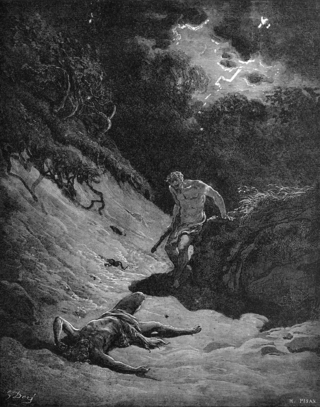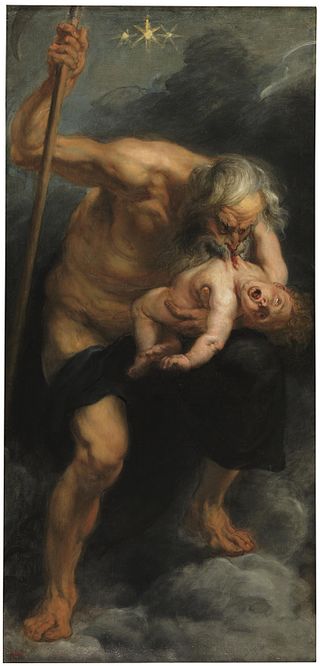
Murder is the unlawful killing of another human without justification or valid excuse committed with the necessary intention as defined by the law in a specific jurisdiction. This state of mind may, depending upon the jurisdiction, distinguish murder from other forms of unlawful homicide, such as manslaughter. Manslaughter is killing committed in the absence of malice, such as in the case of voluntary manslaughter brought about by reasonable provocation, or diminished capacity. Involuntary manslaughter, where it is recognized, is a killing that lacks all but the most attenuated guilty intent, recklessness.

Homicide is an act in which a person causes the death of another person. A homicide requires only a volitional act, or an omission, that causes the death of another, and thus a homicide may result from accidental, reckless, or negligent acts even if there is no intent to cause harm. It is separate from suicide.

Filicide is the deliberate act of a parent killing their own child. The word filicide is derived from the Latin words filius and filia and the suffix -cide, from the word caedere meaning 'to kill'. The word can refer to both the crime and perpetrator of the crime.

Patricide is the act of killing one's own father. The word patricide derives from the Latin word pater (father) and the suffix -cida. Patricide is a sub-form of parricide, which is defined as an act of killing a close relative. In many cultures and religions, patricide was considered one of the worst sins. For example, according to Marcus Tullius Cicero, in the Roman Republic it was the only crime for which the civilian could be sentenced to death.
Vehicular homicide is a crime that involves the death of a person other than the driver as a result of either criminally negligent or murderous operation of a motor vehicle.

Matricide is the act of killing one's own mother.
Uxoricide is the killing of one's own wife. It can refer to the act itself or the person who carries it out. It can also be used in the context of the killing of one's own girlfriend. Conversely, the killing of a husband or boyfriend is called mariticide.
A murder–suicide is an act where an individual intentionally kills one or more people before killing themselves. The combination of murder and suicide can take various forms:
Capital murder refers to a category of murder in some parts of the US for which the perpetrator is eligible for the death penalty. In its original sense, capital murder was a statutory offence of aggravated murder in Great Britain, Northern Ireland, and the Republic of Ireland, which was later adopted as a legal provision to define certain forms of aggravated murder in the United States. Some jurisdictions that provide for death as a possible punishment for murder, such as California, do not have a specific statute creating or defining a crime known as capital murder; instead, death is one of the possible sentences for certain kinds of murder. In these cases, "capital murder" is not a phrase used in the legal system but may still be used by others such as the media.
Murder is an offence under the common law legal system of England and Wales. It is considered the most serious form of homicide, in which one person kills another with the intention to unlawfully cause either death or serious injury. The element of intentionality was originally termed malice aforethought, although it required neither malice nor premeditation. Baker states that many killings done with a high degree of subjective recklessness were treated as murder from the 12th century right through until the 1974 decision in DPP v Hyam.
In the English law of homicide, manslaughter is a less serious offence than murder, the differential being between levels of fault based on the mens rea or by reason of a partial defence. In England and Wales, a common practice is to prefer a charge of murder, with the judge or defence able to introduce manslaughter as an option. The jury then decides whether the defendant is guilty or not guilty of either murder or manslaughter. On conviction for manslaughter, sentencing is at the judge's discretion, whereas a sentence of life imprisonment is mandatory on conviction for murder. Manslaughter may be either voluntary or involuntary, depending on whether the accused has the required mens rea for murder.
Beverley Gail Allitt is an English serial killer who was convicted of murdering four infants, attempting to murder three others, and causing grievous bodily harm to a further six at Grantham and Kesteven Hospital, Lincolnshire, between February and April 1991. She committed the murders as a State Enrolled Nurse on the hospital's children's ward.
Manslaughter is a common law legal term for homicide considered by law as less culpable than murder. The distinction between murder and manslaughter is sometimes said to have first been made by the ancient Athenian lawmaker Draco in the 7th century BC.
Internet homicide, also called internet assassination, refers to killing in which victim and perpetrator met online, in some cases having known each other previously only through the Internet. Also Internet killer is an appellation found in media reports for a person who broadcasts the crime of murder online or who murders a victim met through the Internet. Depending on the venue used, other terms used in the media are Internet chat room killer, Craigslist killer, Facebook serial killer. Internet homicide can also be part of an Internet suicide pact or consensual homicide. Some commentators believe that reports on these homicides have overemphasized their connection to the Internet.
Crime rates in Alabama overall have declined by 17% since 2005. Trends in crime within Alabama have largely been driven by a reduction in property crime by 25%. There has been a small increase in the number of violent crimes since 2005, which has seen an increase of 9% In 2020, there were 511 violent crime offenses per 100,000 population. Alabama was ranked 44th in violent crime out of a total 50 states in the United States.
In Denmark manddrab (manslaughter) is the term used by the Danish penalty law to describe the act of intentionally killing another person. No distinction between manslaughter and murder exists. The penalty goes from a minimum of five years to imprisonment for life. The standard punishment for manslaughter - i.e. where there are neither aggravating nor mitigating circumstances - is 12 years imprisonment. If the perpetrator is sentenced to life in prison, 12 years must pass before they can file for probation.
In the United States, the law for murder varies by jurisdiction. In many US jurisdictions there is a hierarchy of acts, known collectively as homicide, of which first-degree murder and felony murder are the most serious, followed by second-degree murder and, in a few states, third-degree murder, which in other states is divided into voluntary manslaughter, and involuntary manslaughter such as reckless homicide and negligent homicide, which are the least serious, and ending finally in justifiable homicide, which is not a crime. However, because there are at least 52 relevant jurisdictions, each with its own criminal code, this is a considerable simplification.
English law contains homicide offences – those acts involving the death of another person. For a crime to be considered homicide, it must take place after the victim's legally recognised birth, and before their legal death. There is also the usually uncontroversial requirement that the victim be under the "King's peace". The death must be causally linked to the actions of the defendant. Since the abolition of the year and a day rule, there is no maximum time period between any act being committed and the victim's death, so long as the former caused the latter.
Manslaughter is a crime in the United States. Definitions can vary among jurisdictions, but manslaughter is invariably the act of causing the death of another person in a manner less culpable than murder. Three types of unlawful killings constitute manslaughter. First, there is voluntary manslaughter which is an intentional homicide committed in "sudden heat of passion" as the result of adequate provocation. Second, there is the form of involuntary manslaughter which is an unintentional homicide that was committed in a criminally negligent manner. Finally, there is the form of involuntary manslaughter which is an unintentional homicide that occurred during the commission or attempted commission of an unlawful act which does not amount to a felony.













